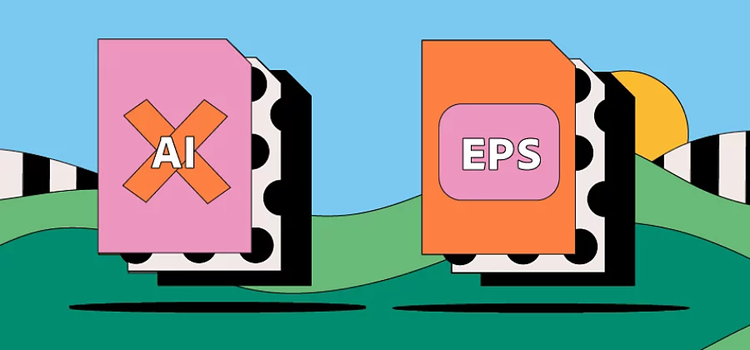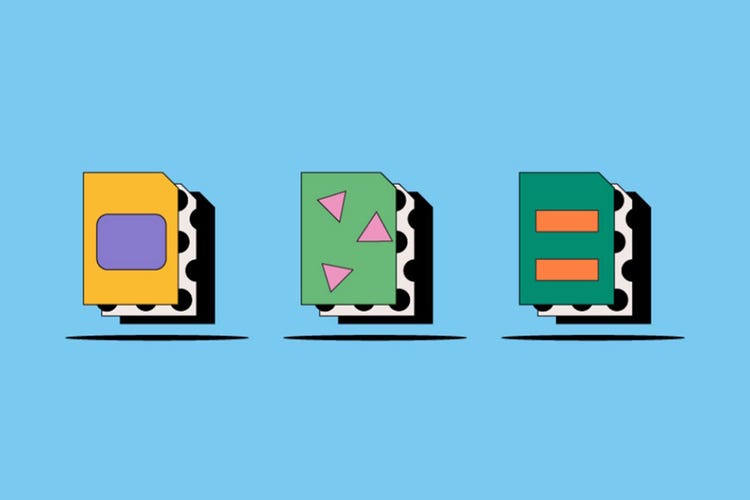DESIGN
AI vs. EPS.
Both pioneers of the vector file format, EPS and AI are standard image file types used in Adobe Illustrator. Although they both support vector graphics, EPS files also can handle bitmap images. Let’s dive into how you can use these two file types today — and what sets them apart from other vector formats.

https://main--cc--adobecom.hlx.page/cc-shared/fragments/seo-articles/get-started-notification-blade
What is an EPS file?
EPS is an acronym for Encapsulated Postscript, a vector file type that saves and stores images, text, and designs so you can reopen and reedit them at any time. In its early days, EPS was an important 2D image file type used primarily for high-quality printing and embedding images into webpages.
What is an AI file?
Adobe designed the AI file to be the default format for Illustrator. AI files make the most of Illustrator’s capabilities, especially when handling vector images. AI image files contain a lot of information and detail, making them ideal for editing artwork after its original creation. Each AI file can contain numerous artboards — the canvas-like spaces where you create and edit your visuals — but the files themselves are limited to one page.
What is the difference between AI and EPS files?
EPS files are older, larger, and more flexible than AI files. AI files, on the other hand, are smaller, yet more detailed, than EPS files. If you want to manage your file sizes, AI may be your go-to file format. Many people consider AI files to be a streamlined and simplified subset of EPS files because of its vector-only support, easier editing capabilities, and wide compatibility.
Originally, EPS files were more widely compatible than AI — but as software programs advanced and increased the number of files they were compatible with, AI files became the more accessible file type. The strong compatibility between the AI and PDF file types also meant they were easier to open than EPS.
History of EPS and AI.
Adobe Illustrator debuted in 1987 and quickly became a leader in graphic design software. In its early releases, Illustrator used EPS as its standard file format. It wasn’t until the release of Illustrator 9.0 that Adobe began to move away from the EPS file in favor of the PGF file, which later became the AI file.
Today, you can use either EPS or AI files to create both simple and complex drawings, illustrations, designs, and more. However, because it’s the proprietary file format for Illustrator, most Adobe users still prefer AI.
Vector vs. bitmap.
A bitmap image is a map of pixels. Each pixel has its own color, which — when combined in large groups — creates a large, detail-rich image. However, pixel-based images are difficult to scale because they consist of many individual pixels. When you scale a pixel-based image to a larger size than intended, it won’t have enough pixels to maintain picture quality at the new size.
Vector graphics use geometry and mathematical proportions — built on a system of points, lines, arcs, curves, and polygons — to create images. They’re ideal for scaling because their foundational lines and shapes retain their ratios at any size.
EPS files can process both bitmap and vector images. AI files only handle vectors.
Complexity of image.
Many designers prefer to use the vector format for certain types of projects due to its precision, quality, and scalability. You can scale vectors down to a business card size or up to the size of a billboard and get the same high quality for both. AI files have the added benefit of being information-rich — they hold a lot of image data detail, making them easy to edit.
For artwork, AI files can handle more complex images than EPS files. A single page contains all its image data plus many different artboards, making the AI format easy to manipulate.
Transparency.
Another advantage of AI files is they support transparency. With layers, transparency helps graphic designers build artwork that they can use anywhere a design needs to seamlessly appear on top of various backgrounds, like a logo on a webpage.
Use cases.
The original use of EPS files was to embed images in websites and print advanced graphics. Today, JPEGs, GIFs, and PNGs have replaced EPS for web use cases. However, EPS remains useful for printing — especially with images that contain complex graphics and high-resolution elements.
AI files are popular for small-scale graphics, especially for those with clean, sharp lines. Graphic designers often use them for logos, icons, posters, and prints. Illustrator is also useful for typography design — creating fonts — and AI files are known for their ability to display fonts with precision.
Looking ahead.
AI files are becoming increasingly more commonplace than EPS. While people still use EPS files, designers and illustrators can just as easily create the same image types in AI files. As the default native format of Adobe Illustrator, AI files will only continue to grow in popularity.
How do I convert a JPEG to EPS?
To convert a raster-based JPEG file to a vector-based EPS on Adobe Photoshop, follow these simple steps.
- Open Adobe Photoshop and select File > Open.
- Select your JPEG from your computer.
- Select File > Save As.
- Choose EPS from the File Types dropdown and click Save.
- Choose your settings in the EPS option panel.
- Click OK and Export.
How do I convert a PDF to an AI file?
Follow these steps to convert your PDF files to AI in Illustrator:
- Open Illustrator.
- Select File > Open and select your PDF.
- Choose File > Save As.
- Select AI from the File Types dropdown menu.
- Select Export.
